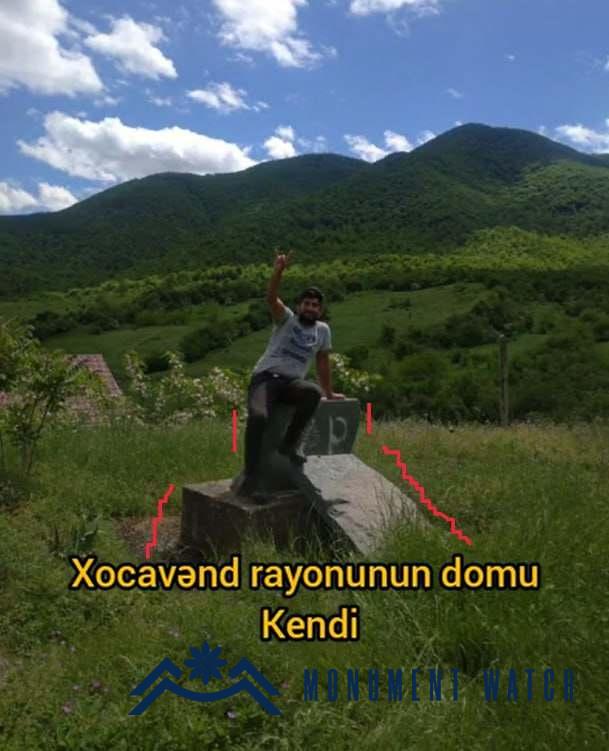Destruction of a Khachkar in Kyuratagh Village, Hadrut
On July 9, 2023, a photograph began circulating in the media, clearly depicting the destruction of the khachkar raised in 2014 in memory of the victims of the Artsakh war. The khachkar was located in the Kyuratagh village of Hadrut, an area now occupied by Azerbaijan. The image shows a young man from Azerbaijan seated on the fallen khachkar's pedestal, which is further marred by inscriptions and displays the emblem of the Grey Wolves (https://t.me/ararathau/18879). The emblem holds significance as the symbol of the Turkic "Nationalist Movement" party, which is regarded as the emblem of the "Grey Wolves." It was prominently utilized by the Turkish-Azerbaijani military during the 44-day war.
The destiny of the adjacent monument, situated alongside the Khachkar and commemorating the victims of World War II, remains uncertain at present.
Our response
The destruction and appropriation of Armenian cultural heritage by Azerbaijan are strictly prohibited by numerous conventions established by UNESCO and the Council of Europe, as well as by provisions outlined by the International Court of Justice and various other authoritative documents.
Regarding the destruction of the khachkar raised in 2014 in Kyuratagh village, which memorialized the victims of the Artsakh war and is located in the occupied region of Hadrut, it is crucial to note that deliberate targeting of khachkars is prohibited by international law. The international community, in particular, appreciates and recognizes the importance of khachkars, as indicated by their inclusion on the UNESCO List of Intangible Cultural Heritage since 2010. This recognition underscores the profound symbolism and craftsmanship inherent in "The art of Armenian khachkars," a cultural tradition that has been safeguarded since 2003. For further information visit: https://ich.unesco.org/en/RL/armenian-cross-stones-art-symbolism-and-craftsmanship-of-khachkars-00434. This underscores the exceptional and all-encompassing universal value of khachkar art, necessitating heightened international protection. Its significance adds to the richness of the global cultural heritage, generating considerable global interest. Moreover, khachkar art is unequivocally acknowledged as Armenian, and irrespective of the preferences of any particular state, its preservation remains imperative.
The Khachkar culture also receives additional protection during and after times of war, particularly through the guidelines outlined in the 1954 Hague Convention on the Protection of Cultural Property in Armed Conflicts. Furthermore, by the principles outlined in the second protocol adopted in 1999, the entirety of the khachkar culture is granted heightened safeguards. Any harm inflicted upon it, as stipulated by Article 15(a) of the protocol, constitutes a "serious violation" and can potentially lead to international court proceedings on charges of war crimes (source: https://www.arlis.am/DocumentView.aspx?DocID=31415).
It is crucial to highlight that the International Court of Justice has affirmed the elevation of laws applicable in occupied territories, encompassing provisions for safeguarding cultural heritage, to the stature of international customary law (infra jurisprudence). This signifies that they function as universally recognized and obligatory principles, binding upon all states (source:https://casebook.icrc.org/case-study/icjisrael-separation-wallsecurity-fence-occupied-palestinian-territory).
